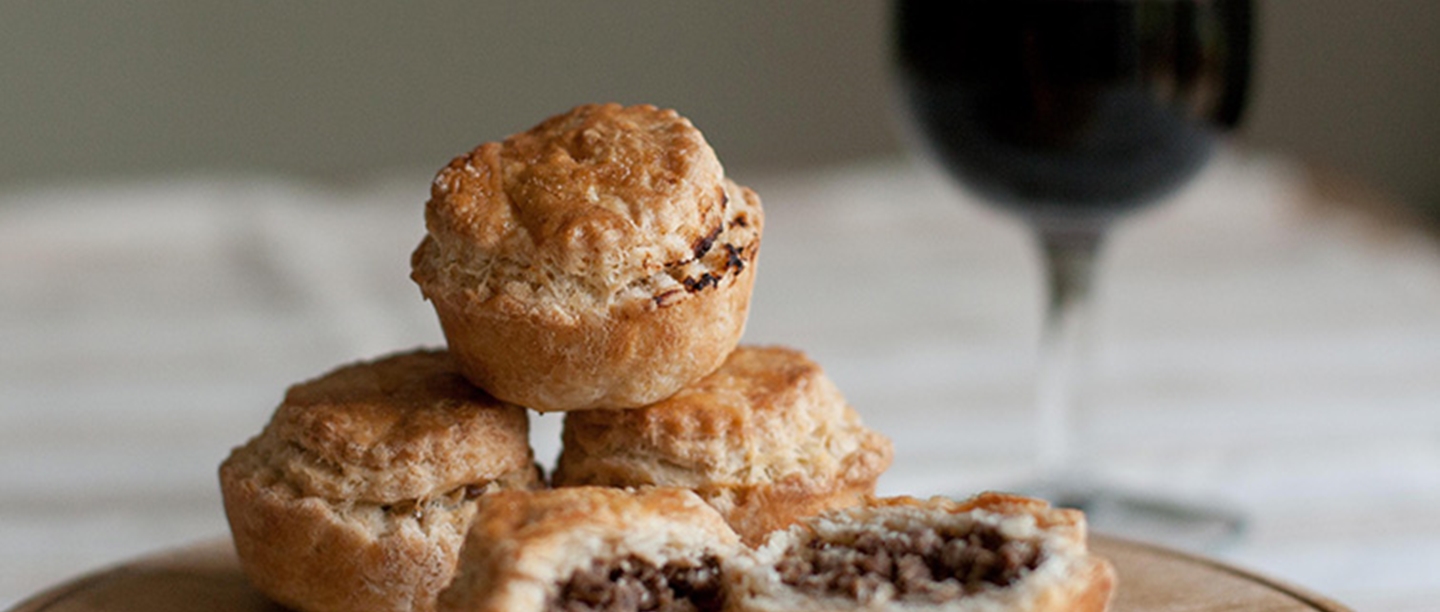
Today there’s nothing remotely savoury about the mince pie. But this wasn’t always the case. Like so many dishes, the mince pie has evolved over the centuries.
We recognise them as the quintessential Christmas confection, packed with citrussy dried fruit plumped with brandy, spiked with spices and wrapped in crumbly pastry. However, long before Nigella introduced salted caramel to the nation, the English had a fascination for combining the sweet with the savoury.
TAKE ONE COFFIN…
Our mince pies undoubtedly have medieval origins, although we would not immediately recognise them. Pie crusts were known as coffins, and used as a vessel to cook delicate foods or house pre-boiled meat fillings. Pastry was little more than flour mixed with water to form a mouldable dough. It was designed to be discarded once the contents of the pie had been eaten, although perhaps the poor may have eaten the cast offs.
Pies were generally large as they needed to serve several people. However, smaller pies known as chewets (possibly so called because the pinched tops resembled small cabbages or chouettes) were also available.
ADD SWEETNESS AND SPICE…
Many medieval recipes combine sweet and savoury ingredients, and pies were no exception. Desserts as we know them didn’t really exist, so it was perfectly acceptable to use sweet ingredients in meat dishes.
Sweetness came courtesy of honey or dried fruits as sugar was not widely available. Along with spices such as saffron and ginger, dried fruits such as figs and dates were the preserve of the wealthy as they had to be imported into the country. Liberally using spices in your food was one way to show your peers just how much money you had.
Detail from ‘Tart de brymlent’ or ‘Tartes of flesshe’ via The University of Manchester Image Library
The fourteenth century ‘Forme of Cury’ gives a recipe for Tart of Flesh (above) which contains figs, raisins, wine, pine kernels, lard, cheese, minced pork, honey and spices. A similar recipe using mutton rather than pork is also given by Gervase Markham in ‘The English Huswife‘, originally published in 1615. Starting to sound familiar?
AND A BABY IN A MANGER…
Due to the costly nature of the ingredients, spiced pies were not every day fare. They would have been served on important feast days such as Easter or Christmas (which were both preceded by lengthy fasts).
As the pies were often baked in a rectangular shape, people began to associate them with the manger Jesus had laid in. Soon dough effigies of the baby Jesus were placed on top of the pies to reinforce the religious connection.
It’s a myth that Christmas and mince pies were banned by Oliver Cromwell and reinstated at the Restoration, but some seventeenth century Puritans did frown on any such ‘idolatrous’ depictions of sacred figures. By end of the century mince pies were made round, with the baby entirely absent.
AND BAKE FOR CENTURIES UNTIL MEAT-FREE
It’s hard to know exactly when meat was dropped from the mince pie. Eliza Acton’s mincemeat recipe in ‘Modern Cookery for Private Families’ (1845) includes ox tongue and ‘Mrs Beeton’s Household Management’ (1861) originally gave two recipes for mincemeat, one with and one without meat (although later editions would only include the meat free version).
Suffice it to say that by the twentieth century the only trace of meat in the eponymous mince pie was the suet, and even this can be replaced by a vegetarian alternative.
1591 Recipe for a Real Mince Pie
INGREDIENTS
For the filling:
- 1 1/2lb (700g) lean mutton or beef
- 4oz (100g) suet
- 1/2 tsp ground cloves
- 1 tsp ground mace
- 1/2 tsp black pepper
- a pinch of saffron
- 2oz (50g) raisins
- 2oz (50g) currants
- 2oz (50g) stoned prunes, chopped
For the pastry:
- 1lb (450g) plain flour
- 2tsps salt
- 4oz (100g) lard
- 1/4 pt (150ml) water
- 4tbsp (60ml) milk
For the glaze:
- 1tbsp (15ml) butter
- 1tbsp (15ml) sugar
- 1tbsp (15ml) rosewater
METHOD
Mince the meat, and mix in the suet, spices, pepper, saffron and the dried fruit.
To make the pastry, sift the flour and salt together into a large mixing bowl and make a well in the centre. Heat the lard, water and milk until boiling and pour into the well. Quickly beat the mixture together with a spoon to form a soft dough, and knead until smooth on a lightly floured board.
Cut off a quarter of the pastry, and keep covered until required to make the lid. Mould the larger piece of pastry to form the base and sides of the pie within an 8 inch (20cm) diameter, 2 inch (5cm) deep loose-bottomed tin.
Pack the meat into the pie and dampen the edges of the pie wall. Roll out the remaining pastry to make a lid and firmly press into place. Trim the edges, using surplus pastry for decoration, and cut a hole in the centre of the lid.
Bake in the centre of the oven at gas mark 7, 220C/425F for 15 minutes, then reduce temperature to gas mark 4, 180C/350F for a further 1 1/4 hours. Remove the sides of the tin, brush with the glaze and return to the oven for a further 15 minutes. Serve cold.
If you try this recipe at home, we’d love to hear about it – leave us a comment below and share your photos with us on twitter @EnglishHeritage
- This recipe was originally published in A Book of Cookrye Very necessary for all such as delight therin printed by Edward Allde, London 1591 and reprinted in Food and cooking in 16th century Britain – History and Recipes by Peter Brears (English Heritage, 1985)
More mincepies? Watch our Victorian cookery series
Mrs Crocombe, the cook at Audley End House, is making enough traditional mincemeat (using ox tongue) to last the whole Christmas season…
- Discover more Christmas recipes and crafts
- Subscribe to our YouTube channel